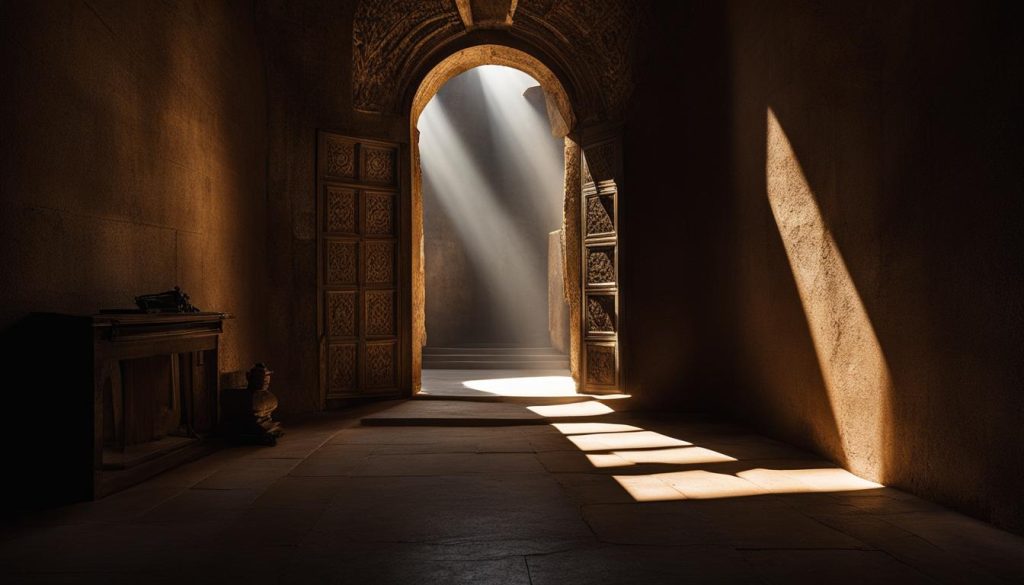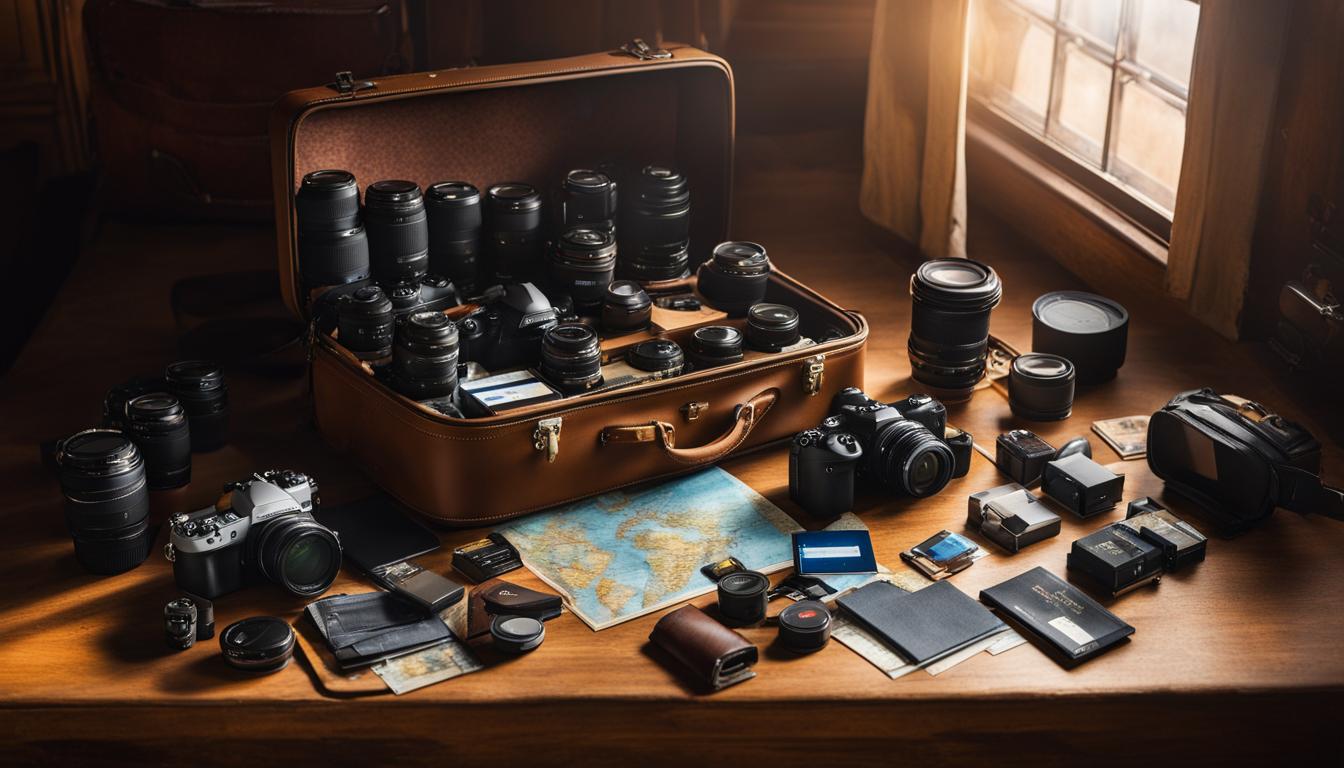Travel photography is all about capturing the beauty and essence of the places and moments you encounter on your adventures. Whether you’re a seasoned photographer or a newbie, packing the right gear and mastering essential techniques can make all the difference in your travel photography.
In this section, we introduce the ultimate travel photography checklist for explorers. This checklist includes everything you need to know to capture every adventure perfectly while traveling. From choosing the right camera and lenses to mastering composition and lighting techniques, we’ve got you covered.
Key Takeaways:
- The ultimate travel photography checklist provides essential tips and recommendations for capturing stunning travel images.
- Choosing the right camera and lenses can make a significant impact on the quality of your travel photographs.
- Essential camera accessories such as tripods, camera bags, memory cards, extra batteries, and filters can improve the versatility and quality of your travel photography gear.
- Composition and framing techniques and mastering light and exposure can elevate the visual appeal of your travel photographs.
- Capturing authentic moments and stunning landscapes can create compelling travel photographs.
Choosing the Right Camera and Lenses
When it comes to travel photography, choosing the right camera and lenses is crucial. Different destinations and photography styles require specific gear to capture the perfect shot. Here’s what you need to know:
Types of Cameras
There are many camera options available for travel photography, including point-and-shoot cameras, mirrorless cameras, and DSLRs. Consider your budget, personal preference, and the demands of your trip when selecting the best camera for your needs.
Tip: Look for cameras with image stabilization features to reduce the chances of blurry photos.
Lens Options
There are countless lens options available for travel photography, but some of the most popular include wide-angle lenses for landscapes, telephoto lenses for wildlife or sports photography, and standard zoom lenses for general use. Consider the weight and portability of your lenses when traveling.
Tip: Renting lenses can be a cost-effective way to try out new gear without committing to a purchase.
Choosing the right camera and lenses can make all the difference in the quality of your travel photographs. Do your research and consider your needs to make an informed decision.
Essential Camera Accessories
Every travel photographer knows that packing the right camera accessories is just as important as having a great camera and lenses. The right accessories can make all the difference in capturing stunning travel images. Here are some essential camera accessories that every travel photographer should have:
Tripod
A tripod can help keep your camera steady, providing clear and sharp images, especially in low-light conditions. Invest in a lightweight and portable tripod, so you won’t have to lug around a heavy and bulky one throughout your travels.
Camera Bag
A reliable camera bag can protect your gear from damage while on the go. Look for a durable and well-designed camera bag with padded compartments that can fit all your essential gear, such as your camera, lenses, and accessories.
Memory Cards
Memory cards are essential to store all your photographs on the go. Always pack extra memory cards and ensure they have enough storage space to capture high-quality images.
Extra Batteries
Bring extra camera batteries to ensure you don’t miss any crucial photo opportunities. Make sure they are fully charged before leaving for your trip.
Filters
Filters can enhance the color and contrast of your images and can be useful to reduce glare and reflections. A polarizing filter is especially useful for landscape photography.
Don’t forget to pack these essential camera accessories in your bag to help you capture stunning travel images.
Composition and Framing Techniques
Creating stunning travel photography requires not only a good eye but also the use of effective composition and framing techniques. By following a few practical tips, you can enhance the overall visual appeal of your photographs and create images that capture the essence of your adventures.
Rule of Thirds
The rule of thirds is a basic principle of photography that involves dividing the frame into thirds vertically and horizontally, creating a grid of nine equal parts. The points where the lines intersect are known as the “power points.” By placing the subject of your image on one of these points, you create a more balanced and visually appealing composition.
Leading Lines
Leading lines are lines within the composition that draw the viewer’s eye to the subject. They can be straight lines, such as a path or road, or curved, like a river or tree branch. By using leading lines, you create a more dynamic and engaging composition, drawing the viewer into the scene and guiding their eye to the focal point of the image.
Patterns and Perspectives
Patterns and perspectives are powerful tools for creating compelling travel photography. Patterns are repetitions of shapes or colors within a scene, while perspectives are the way objects in the image relate to each other and the viewer. By finding interesting patterns and perspectives, you can create images that capture the beauty and complexity of a particular place or moment.
Mastering Light and Exposure
Properly mastering light and exposure is crucial for producing stunning travel photographs. Understanding how to work with natural light and optimize exposure settings can take your photography skills to new levels. Here are some tips to help you master light and exposure in travel photography:
Understanding Natural Light
One of the most important elements of working with light in photography is understanding natural light. Whether you’re shooting in bright sunlight, overcast conditions, or during the golden hour, recognizing the qualities of light in your surroundings is essential.
During the golden hour(SEO relevant keywords: golden hour), the light has a warm, soft glow that can create stunning photographs. Consider shooting during this time of day to capture your subject bathed in a beautiful, golden light.
Using Different Lighting Conditions to Your Advantage
While we often think of natural light as the best light source, there are times when artificial light sources can be just as effective. For example, when shooting portraits indoors, using various lighting sources such as lamp(SEO relevant keywords: lamp) can add dimension and texture to your image.

Mastering Exposure Settings for Different Situations
Finally, mastering exposure settings is essential for capturing the perfect shot. When shooting in tricky lighting conditions, such as high contrast scenes, you’ll want to manually adjust your exposure settings to ensure that your subject is properly lit. Take some time to practice adjusting your shutter speed, aperture, and ISO settings to see how they impact your final image.
With these tips and techniques, you can begin to master light and exposure in your travel photography. Understanding natural light, using different lighting conditions to your advantage, and mastering exposure settings will help you take your photography to new heights.
Capturing Authentic Moments and Landscapes
When it comes to travel photography, capturing authentic moments and stunning landscapes is crucial. While exploring new places, try to remain present and aware of your surroundings. Look for unique details, vibrant colors, or intriguing patterns that can add depth and character to your shots.
Tip: One powerful way to capture authentic moments is to photograph people going about their everyday lives. Candid shots will not only reflect the local culture and lifestyle but also add a human element to your travel photos.
Another great technique is to work with subjects and ask for permission before taking their picture. Whether it’s a street performer or a group of kids playing, engaging with your subjects can lead to more genuine and memorable shots.
Whether you’re photographing people or landscapes, composition is key. Utilize the rule of thirds to create a balanced and visually pleasing shot. Consider foreground elements and leading lines to guide the viewer’s eye and add depth to your images.
Tip: When capturing landscapes, pay attention to the lighting and time of day. The golden hour – the period just after sunrise or before sunset – will provide warm light and enhance the natural beauty of your surroundings.
By following these tips and techniques, you can create compelling travel photographs that truly capture the essence of your adventures.
Conclusion
Congratulations! You’ve made it to the end of our ultimate travel photography checklist for explorers. We hope that our tips and recommendations have been helpful for you in capturing perfectly every adventure you embark on.
Remember, choosing the right camera and lenses, utilizing essential accessories, mastering composition and lighting techniques, and capturing authentic moments and landscapes are all key elements to elevate your travel photography. With this checklist in hand, you’re ready to pack your gear, set off on your next journey, and snap incredible photographs along the way.
Happy travels and happy snapping! 📷






